
New photos show a breakthrough in the construction of the first underground physics laboratory in the southern hemisphere, at the Stawell Gold Mine in Victoria.
The pictures reveal two connected underground caverns being excavated to house the laboratory, one kilometre deep in the mine. The laboratory consists of a main research hall and a side access wing configured in an ‘L’ Shape.
The new images, which are available via the media kit, detail where the two caverns intersect, with the underground excavation breaking through to connect the two caverns.
The excavation work, which is being completed by the owner operator of the gold mine, Stawell Gold Mines, began in August 2019 and is expected to take another two months.
Approximately 3000 metres has been excavated.
The University of Melbourne’s Professor Elisabetta Barberio, who heads the Stawell Underground Physics Laboratory project, said the excavation breakthrough is a step closer to the discovery of dark matter.
Understanding how the universe was formed from dark matter is one of the world’s biggest mysteries, one which Professor Barberio is hoping the laboratory at Stawell will help solve.
“The Centre will establish the Stawell Underground Physics Laboratory as the southern hemisphere’s epicentre for dark matter research and a national facility that is desired for other disciplines,” she said.
“It will provide a dynamic environment for advances in ultra-sensitive detectors, ultra-low radiation techniques, spin-technology translation, and highly trained graduates ready to lead innovation in Australian industry.”
Construction completion is planned for late 2020 with operations expected to commence in early 2021.
The Commonwealth and State Governments have each allocated $5 million in funding for the building of the facility.
In August, funding was boosted by the Australian Research Council awarding a $35 million Centre of Excellence for Dark Matter Particle Physics to search for dark matter. The Centre will establish the Stawell Underground Physics Laboratory as the southern hemisphere’s epicentre for dark matter research and a national facility that is desired for other disciplines.
The partners for the laboratory are the Australian ³Ô¹ÏÍøÕ¾ University, the University of Adelaide, Swinburne University and ANSTO.






/SSM-49520_AoA_AppliedMechanicsLab_(DynamicsLab)241001-131027q10.jpg/_jcr_content/renditions/cq5dam.web.1280.720.jpeg)

